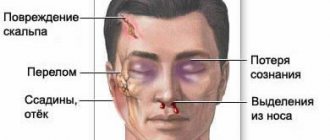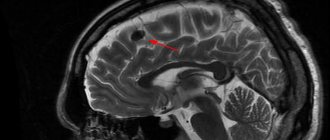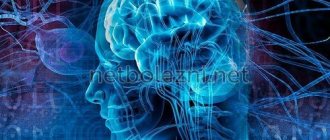The brain is the main organ of the central nervous system. It consists of more than 35 billion cells. There are 5 parts of the brain that interact with each other using neural connections:
- Oblong. Responsible for protective reflexes (sneezing, coughing, vomiting), food (sucking, salivation, swallowing) and cardiovascular (regulation of the heart and blood vessels, as well as breathing and hearing).
- Posterior section. His “conscience” includes facial expressions, chewing reflexes, balance and muscle function.
- The middle one is responsible for muscle tone and skin pigmentation.
- Intermediate regulates metabolism, cardiovascular activity and sleep.
- The final (large) is the highest center of mental activity. Responsible for smell, hearing, vision, movement.
call me back
Brain Facts
- The average brain weight is 1300-1400 grams. That is, having a mass of no more than 2% of the entire body, it consumes a quarter of all energy.
- The brain is 60% fat.
- Has no pain receptors. Therefore, when neurosurgeons perform operations, they inject painkillers only into the scalp
- From large doses of alcohol, the brain loses the ability to create memories. Therefore, when a person has a large dose of alcohol, he does not remember the events that occur.
- The brain often doesn’t care whether you actually do something or imagine it in pictures. If you imagine a dangerous and extreme situation in your mind, your heart rate will immediately increase. This feature of our psyche has long been known to athletes. Many of them do visualization before competitions: they imagine all sorts of situations that could happen to them during tournaments. Research has proven that this method improves the performance of athletes because it prepares their muscles and body.
- There is a phenomenon known as phantom pain. For example, when a person's leg is amputated, he still experiences pain in it. This happens because there are nerve endings in the brain that are responsible for sensing pain in that leg.
Treatment of necrosis
The disease in question can be successfully treated, but only if it is carried out in a medical institution and under constant monitoring by doctors. General principles of therapy:
- Necrosis of the teeth, jaw or gums is diagnosed quite quickly, because it is accompanied by severe pain and an extremely unpleasant odor from the oral cavity. Patients, as a rule, immediately seek medical help and therefore treatment consists of prescribing medications - antibacterial drugs, disinfectants. In some cases, dentists have to surgically remove already necrotic areas of soft tissue.
- Necrosis of tissues of internal organs is often diagnosed already in the extreme stages. For example, the symptoms of pancreatic necrosis are often blurred. Even when visiting a doctor, the patient is often given an incorrect diagnosis, which can lead to the death of a large number of cells in the internal organ. Typically, pancreatic necrosis is treated surgically, but the prognosis in this case can be very different - from favorable (full recovery) to imminent death.
- Bone death almost always requires surgery. Surgery for necrosis of the hip joint, for example, involves removing the problem area and using an endoprosthesis. With timely diagnosis, such treatment always has a favorable prognosis.
- The stages of liver necrosis are the main factor in choosing the method of its treatment. If at the initial stage drug therapy is quite acceptable, then at the moderate and severe stages only surgery is considered.
Consultation on how intestinal necrosis is treated and what the first symptoms of the pathology are can only be obtained from a qualified doctor. You can make an appointment on our website Dobrobut.com.
Symptoms of brain diseases
The most common brain diseases include atherosclerosis, stroke, tumor, vascular aneurysm, and Alzheimer's disease. According to statistics, up to 85% of people are predisposed to developing diseases related to the blood supply to the brain. Such data are a consequence of the unhealthy lifestyle of modern man. The danger of brain diseases lies in their asymptomatic nature. That is, for a long time they do not make themselves felt.
Common symptoms of brain diseases include:
- Frequent headaches that do not go away even after taking medications.
- Memory impairment.
- Constant fatigue.
- Fainting.
- Cramps.
- Fever. Body temperature can reach up to 40 degrees.
- Weight loss to the point of exhaustion.
Specific symptoms of atherosclerosis:
- Noise in ears. It occurs when a cholesterol plaque has blocked 60% of the blood flow in an artery.
- Decreased erection. If a man under 50 years of age has decreased erection, then such a patient's risk of dying from a myocardial infarction is many times higher than that of the same person with normal erectile function.
- Coldness in the extremities. The vessels become stiffer and blood flows through them worse.
Specific symptoms of stroke:
- Numbness of the face and limbs.
- Double vision.
- Difficulty moving.
Every third death in Russia is associated with this pathology.
Stroke happens:
- Ischemic. Associated with blockage of arteries, cessation of blood flow to the brain and necrosis of its tissue. The cause of the appearance is blockage of blood vessels leading to the brain due to atherosclerotic plaque. The second reason is the occurrence of a blood clot in the heart when it is not working properly (for example, during an arrhythmia). As a result, the blood clot “runs” into the brain vessels, causing thrombosis.
- Neurological. Associated with hemorrhage and hematoma formation inside the skull. It occurs due to high blood pressure when, at its peak, a small vessel inside the brain ruptures and a hematoma appears.
There are signs of a stroke that, if recognized in time, can save a life. To make it easier to memorize, they can be combined into the word “IMPACT”:
- Smile. If a person cannot smile and one of the corners of his mouth is drooping.
- Movement. A person cannot move both arms or legs at once.
- Articulation. A person cannot say anything clearly, not even his name.
- Solution. To save a person, you should take him to the hospital and carry out the necessary examinations within 1-2 hours.
Specific symptoms of Alzheimer's disease:
- Avoiding contact with people.
- Lost in space.
- Decreased emotionality and interest in life.
- Hallucinations.
Alzheimer's disease is a form of dementia that occurs in older people. It is most often found in patients who have crossed the threshold of 65 years. At the moment it is incurable.
Specific symptoms of a brain tumor:
- The headache does not go away within two weeks to a month.
- Headache is accompanied by vomiting, hearing loss and coordination.
- Motor perseverations (inability to stop performing an action).
- Inattentiveness and forgetfulness progresses.
Brain tumors are divided into benign, malignant and metastases. In the case of benign, the disease develops gradually, slowly and gently over several years.
Types of brain tumors:
- Intracerebral. The most common and aggressive form is glioblastoma. It is almost impossible to defeat her. The tumor grows through healthy tissue and cannot be localized.
- Extracerebral. They grow on the base or surface of the skull.
- Metastases are secondary brain tumors. The main cancer cells penetrate the bloodstream into the brain and cause the growth of metastases.
Sign up for a consultation
What is the disease and how does it progress?
Necrosis is one of the most terrible diseases, in which the vital activity of tissues, cells and internal organs ceases. Most often, this condition is caused by the activity of harmful microorganisms, as well as chemical, mechanical and thermal agents that have a destructive effect. The disease can also manifest itself as a result of severe allergic reactions or due to problems with blood circulation and severe hypothermia in this area. With severe overheating, excessive metabolism is noted, and in case of problems with blood circulation, the likelihood of a necrotic process increases.
The first signs of pathology are numbness and a low sensitivity threshold. In this case, you should immediately seek help from a specialist. Additional symptoms include pale skin, which is associated with impaired blood circulation. Over time, the skin may become an uncharacteristic shade - yellow, gray, green or blue. If the legs are affected, the patient complains of rapid fatigue when walking, a feeling of cold and cramps. As a result, trophic ulcers are formed that will not heal and will soon lead to necrosis of tissue and skin.
All this together negatively affects the functioning of the central nervous system, respiratory organs, kidneys and liver, the general condition noticeably worsens, the immune system weakens, metabolism is disrupted, and blood diseases may appear.
Risk factors
Brain diseases can be caused by various reasons related to lifestyle, as well as existing health problems.
- Smoking. Nicotine and other substances contained in tobacco smoke provoke atherosclerosis and vascular aneurysm at a high rate.
- Low physical activity. Physical education improves the plasticity of the brain - its ability to create new connections and transform itself. Accordingly, if a person does not perform even minimal exercise, his brain does not create new neural connections and quickly destroys old ones.
- Male gender. According to research, men are more likely to suffer from brain diseases because they lead an unhealthy lifestyle.
- High blood pressure. As a result of surges in blood pressure, protrusion of the vessel wall in a weak spot may occur.
- Poor nutrition and obesity. If a woman’s waist exceeds 88 cm, and a man’s waist exceeds 102, it is necessary to adjust your diet. With obesity, insulin insensitivity develops (cells lose sensitivity to the hormone, and the pancreas produces more of it than normal).
- Alcohol. The alcohol contained in alcoholic drinks is absorbed into the blood, enters the brain and destroys its cortex.
- High cholesterol. It affects blood vessels, forming cholesterol plaques on their walls, interfering with normal blood flow.
- Stress. Recent studies have shown that stress impairs brain function due to the production of cortisol (the stress hormone).
- Age. Many diseases begin to appear younger and appear at an earlier age than decades ago. For example, cholesterol plaques begin to form in the blood vessels of the brain by the age of 35, which can lead to atherosclerosis.
- Genetics. If your close relatives have developed brain diseases under 50 years of age, then you are at high risk.
- Infections and inflammations. They affect the brain matter, disrupting the functioning of the immune system and brain.
Cytokine storm
Encephalopathy (dystrophic damage to brain tissue) can develop due to the fact that the cells of the immune system of a person infected with coronavirus begin to actively release cytokines into the blood. This class of substances includes about a hundred complex proteins involved in many immune and inflammatory processes in the human body, Nikolai Karpov, an employee of the Institute of Biology of Tyumen State University, told Izvestia. The increase in the concentration of such proteins is called a “cytokine storm.”
“In excess, these substances can damage the walls of blood vessels and cause hemorrhages in the brain, which leads to the development of certain neurological symptoms (depending on the affected area),” the expert said. “It is also possible that the virus can penetrate the blood-brain barrier directly into the brain tissue.
Electron microscopic image of coronavirus reproduction
Photo: REUTERS/US NIAID-RML
According to the scientist, not only coronavirus, but also influenza, as well as other acute respiratory viral infections, can cause encephalopathy, but this complication is rare. In general, science knows dozens of viral diseases, which in a certain percentage of cases cause neurological complications. For example, the viruses of tick-borne encephalitis, measles, herpes types 1 and 2 and West Nile fever, almost all alphaviruses, including the Karelian fever virus (an acute infection believed to be carried by mosquitoes of the genus Culex. - Izvestia) and a lot others.
Corona pressure: hypertension has become the most common companion of COVID-19
At the same time, stress and panic can worsen the course of cardiovascular diseases, Russian scientists believe










